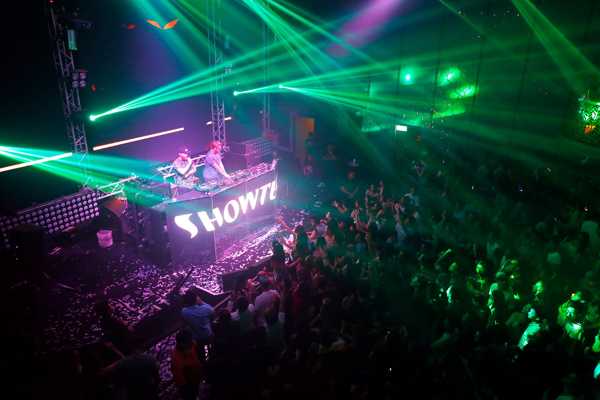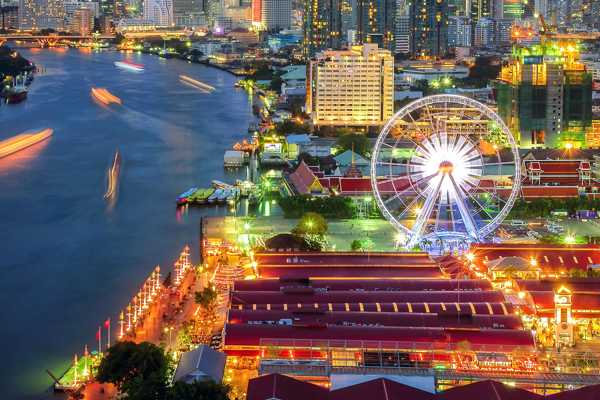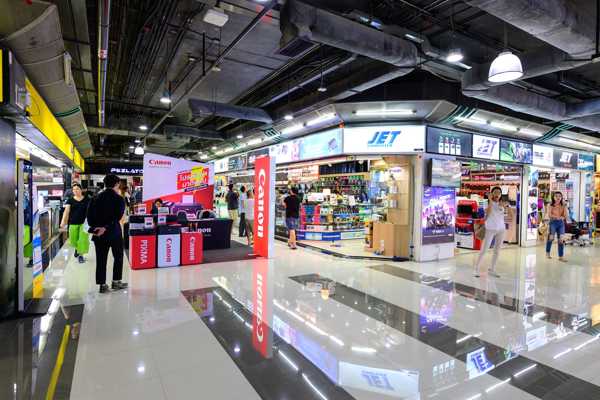Our Bangkok Travel Essentials lays out the essential information you need to help you plan your trip to the capital of Thailand. No matter how frequently you travel, some questions will always need answers: What’s the weather like? How can I get from Suvarnabhumi International Airport airport to my hotel? What currency and type of plug do I need?
We have all these answers plus other basic info about the best time to go, getting there, getting around, and a few useful travel tips. You’ll also learn about the most popular landmarks in Bangkok such as The Grand Palace, Wat Pho, and Khaosan Road. It’s all compiled in this Bangkok Travel Essentials. After reading this short and easy-to-read guide, you will be a little more prepared to start your trip to Bangkok, Thailand.
Best time to travel to Bangkok (weather-wise)

- Bangkok has a tropical monsoon climate with cool, dry winters and hot and humid summers.
- Average temperatures range from about 20°C in winter to 40°C in summer.
- Rainfall in Bangkok mostly occurs in the low season, between May and October. The rainiest months are September and October, with an average of 24.33 rainy days in September.
- The driest months of the year are December, January and February. The hottest months are March, April and May.
- December to February is the best time to visit, despite being the peak tourist season. While flight and accommodation costs will be higher at this time of year, the weather is comfortably cool and dry.
Bangkok basics

- Primary language: Thai (English is widely spoken)
- Plug types: A, B and C
- Electricity: 230 V
- Currency: Thai baht (฿)
- International dialling code: +66
- Emergency telephone number: 191
See also
- 4 Weird Museums in Bangkok

4 Weird Museums in Bangkok
Thailand - 4 Best Pad Thai in Bangkok

4 Best Pad Thai in Bangkok
Thailand - Onyx Bangkok Nightclub

Onyx Bangkok Nightclub
Thailand
How to get to my hotel in Bangkok?

Suvarnabhumi International Airport (BKK)
Bangkok’s Suvarnabhumi Airport is Thailand’s biggest and busiest airport, with about 65 million passengers passing through it every year. It sits about 32 km east of Bangkok city centre, with 2 runways serving a single main terminal building. The terminal is home to a good choice of dining and shopping options, with free Wi-Fi, banking and currency exchange services. There are several transfer options to help you reach downtown Bangkok:
- Taxis are available 24/7 from outside Entry Gate 4 on the 1st floor of the Arrivals Hall. Tell the attendant at the queue your final destination and you will be assigned a driver and escorted to the vehicle. It should take about 40 minutes to drive to central Bangkok, with an additional airport fee and any highway tolls besides the taxi fare. Airport limousine services are also available, but the cost is significantly greater.
- The Airport Rail Link takes passengers from the underground floor of the Arrivals Hall to various stops in the eastern part of Bangkok before connecting to the BTS and MRT lines. Operating from 6 am to midnight, this is one of the most convenient and cost-effective ways of getting into the city.
- The Airport Express Bus has a flat rate and covers 4 routes: Silom Road, Sukhumvit Road, Khaosan Road and Hua Lampong Railway Station. Journeys usually take about 45 minutes. Contact the service counter at Entry Gate 8, on the 1st floor of the Arrivals Hall, for more information. This service runs daily from 5 am to midnight.
- You can access 11 public bus routes from Public Transport Centre outside the main terminal building. You can get there using the Airport Shuttle Service from Entry Gate 5. While this method of getting into Bangkok is the cheapest, it can be slow and not all routes operate 24 hours.
- Car rental agencies can be found between Entry Gates 7 and 8 and are available 24 hours.
Don Mueang International Airport (DMK)
Don Mueang Airport is Bangkok’s main hub for domestic and regional flights, especially those operated by low-cost carriers. It has 2 runways serving 1 terminal building. As one of the world’s largest budget carrier airports. The airport is comparatively close to the city centre, and there are a few ways to get to your hotel from here:
- The taxi rank is in a separate building from the Arrivals Hall. Turn left as you leave baggage claim and keep following the signs – it’ll only take a few minutes to get there. There is an airport surcharge on top of the meter price for the ride.
- There are 4 shuttle bus routes that operate from just outside the Arrivals Hall exits. A1 goes to the Bangkok Bus Terminal via the Mo Chit BTS Skytrain Station, A2 goes to Victory Monument, A3 goes to Lumpini Park and A4 goes to Khaosan Road. You can ride on the bright orange buses, but space for luggage is limited.
- The Don Mueang railway station is just across the road from the airport and connects to Bang Sue Grand Station. However, trains are very infrequent.
Travelling to Bangkok by train
Bang Sue Grand Station is the main rail hub for Bangkok, though various smaller stations are dotted around the city. With 26 platforms, it’s one of the biggest railway stations in Southeast Asia. Services operate from here to destinations around Bangkok and the rest of Thailand. Located in the north of the city, you can get from here into the city centre using the MRT (it has its own station the Blue Line), taxis and buses.
Travelling to Bangkok by bus
Thailand is crisscrossed by bus routes, with larger coaches for long distances and small minivans for medium and short distances. There are 3 main stations for these services around Bangkok:
- Northern Bus Terminal (Mo Chit) is the main station for minivans and coaches heading north. It is near the Mo Chit BTS Skytrain Station.
- Southern Bus Terminal (Sai Tai Mai) serves destinations in the west and south of Thailand. It is about 2 km from the Taling Chan railway station.
- Eastern Bus Terminal (Ekkamai) serves destinations down the eastern seaboard – especially Pattaya. It’s right next to the Ekkamai BTS Skytrain Station.
How to get around Bangkok?

Travel tips
If you include the old part of the city, Bangkok’s city centre spans about 13 sq km which, when you factor in the tropical heat, is a little challenging to explore on foot. While it is possible to get around by walking, it’s somewhat uncomfortable and impractical. For example, getting from such highlights as the Grand Palace and Wat Pho to the shopping centres of Siam Square would take over 1 hour, covering about 5.6 km. Fortunately, there is a good range of public and private transport services to make things easier.
How do the BTS and MRT work?
The most convenient public transport systems in Bangkok are the BTS (Bangkok Mass Transit System, otherwise known as the Skytrain) and the MRT (Metropolitan Rapid Transit). While very similar in nature, they are operated by separate companies and require different passes to ride. However, between them, they provide easy, comfortable and affordable transport around most of the centre of Bangkok and into some popular outlying neighbourhoods.
- Trains arrive every 3-6 minutes on both systems. The BTS runs from 6 am to midnight while the MRT starts from 5.30 am on weekdays and 6 am on weekends and holidays.
- Tickets for both systems are sold at the stations and must be purchased before you can access the platforms. Both use rechargeable cards, but you will need separate cards for the BTS and MRT.
Travelling by public buses
The Bangkok Mass Transit Authority (BMTA) provides bus services to people living and working in Bangkok and provinces like Nonthaburi, Pathum Thani, Samut Sakhon, Samut Prakan, and Nakhon Pathom). BMTA covers over 100 routes and has more than 3,000 buses, including regular and air-conditioned buses as well as privately-owned buses and minibuses.
- Most buses (except for all-night ones) run between 5 am and 11 pm daily.
- Regular buses cost less than expressway buses. There are air-conditioned buses (cream-blue), all-night buses (cream-red), and EURO II buses (yellow-orange). Fares depend on the distance travelled.
- Tickets are bought from the conductor on the bus but remember to bring some small change. With the cost of tickets being so low, they will struggle to make change from even 100 baht.
Travelling by songthaews in Bangkok
Like most major cities in Thailand, Bangkok has a number of songthaew routes circling around busy neighbourhoods. Songthaews are covered pick-up trucks with 2 benches fitted in the back, giving them their name that literally translates to “2 rows”. They generally follow a circular route but it’s often hard to figure out exactly where it’s going. It’s best to ask the driver before you get on board. They will also tell you how much money you need to give them at the end of the trip. It usually isn’t much, but prices vary between areas and routes.
Tuk-tuks in Bangkok
The iconic tuk-tuk is one of Thailand’s most famous vehicles. The brightly-colour motorised rickshaws can be seen lined up outside most major tourist attractions and patrolling the older parts of the city. While riding in one is a bit of an adventure, there is no meter or formalised fee structure, so you will have to haggle the price with the driver before you depart. However, they are surprisingly speedy and agile, and their small size allows them to use routes that cars would struggle with, so they can be good for getting around quickly.
Taking a taxi
Taxis can be hailed on the street in Bangkok, and they’re not difficult to spot. They are painted in vivid colours, with different combinations denoting different cooperatives and companies.
- All taxis use a meter and the rates are regulated. Just make sure the driver switches the meter on at the start of the trip.
- Taxis mostly only take cash, though some may accept payment by bank transfer using a QR code.
- Tips are not mandatory, but you can round up the bill if you’re happy with your driver’s service.
- For shorter trips, motorbike taxis are quicker, though riding one can be a little scary. Each driver wears a distinctive orange vest. These do not have a meter so you will need to negotiate the price before departing.
Water taxis in Bangkok
You can explore a surprising amount of Bangkok from the water, either on the Chao Phraya River or the many khlongs (canals) that spread out from it. There are several different types of water taxis to choose from:
- Express Boat river taxis operate like buses along the river. Depending on exactly which service you choose, they may stop at every pier, main piers or only at the first and last. Costs vary by service.
- There are 32 separate river-crossing ferry services along the Chao Phraya River. Tickets are very cheap and they sail from one bank to the other and back throughout the day. This is especially convenient if you want to get from the Grand Palace to Wat Arun.
- Long-tail boats are the tuk-tuks of the waterways. While they are generally quick and quirky, you will need to haggle to get the price to a sensible level.
- Canal boats are the buses of the khlongs. Large, loud and surprisingly speedy, they run right through the city from the Old City to Ramkamheng. There’s usually a boat every 5-20 minutes, with the cost depending on the distance travelled, though rarely exceeding 20 baht.
Cycling around Bangkok with Pun Pun
The Pun Pun bike-sharing system provides a greener way of getting around Bangkok. There are about 50 stations around the city centre with space for 10 bikes at each, operating from 6 am to midnight.
- You will need to register at the Pun Pun Smart Bike Service website and then collect your Pun Pun smart card from one of the major bike stations. The card price includes life insurance as well as credit.
- To use a bike, tap your card on the screen at a station and enter your verification code. Choose your bike and take your card on the dock to unlock the bike.
- Use for less than 15 minutes is free and between 15 minutes and an hour costs you your first amount of baht. The price then increases in small increments up to a maximum amount of baht for more than 8 hours of cycling.
- Note that Bangkok’s roads can be very hazardous, so be extremely careful if you choose to get around by cycling.
What are the main annual events in Bangkok?

Chinese New Year
- What: Chinese New Year brings one of the most exhilarating celebrations to Yaowarat. The entire length of the street comes to life with crowds of worshippers, exploding firecrackers, dragon dancers, and families of Chinese descent who gather to partake in the street fanfare as well as to enjoy sumptuous Chinese banquets.
- When: varies, but usually around February
- Where: Bangkok Chinatown (Yaowarat)
Songkran
- What: The hottest month of the year, April sees the entire country go bananas in friendly water fights and street parties that last nearly a week. The best places to play in Bangkok include Khaosan Road and Silom, but you’re likely to get soaked almost anywhere you go.
- When: 13-15 April
- Where: nationwide
Loy Krathong
- What: Loy Krathong falls on the full-moon night of the 12th lunar month, when rivers are filled to the brim and the moon shines at its brightest. Thais gather along the riverbanks with their lit krathongs (vessels made of banana trunks or polystyrene), then release them down the river. Well into the night, the rivers shimmer under the moonlight, as flickering candles send a thousand pinpoints of light far into the horizon.
- When: November
- Where: all waterways in Bangkok, nationwide
What are the main landmarks in Bangkok?

The Grand Palace and Wat Prakaew
The Grand Palace and Wat Prakeaw are some of the most beautiful and iconic buildings in Bangkok. The former was built in 1782 and served as the home of Thai monarchs for 150 years. The latter is home to the Emerald Buddha – a sacred Buddha image carefully carved from a single block of emerald.
Wat Pho
Wat Pho is a sprawling temple complex close to the Grand Palace, with fascinating murals, inscriptions and sculptures depicting everything from warfare to astronomy. The star attraction is the Reclining Buddha – a 46-metre-long representation of Buddha’s entry into Nirvana, which was built in 1832.
Khao San Road
Known as one of Bangkok’s main backpacker hubs, Khao San Road is a collision of east and west. While it’s located in the Old City, the street is lined with modern, sleek clubs, bars and restaurants, as well as an eclectic range of market stalls.
This article includes opinions of the Go Guides editorial team. Hotels.com compensates authors for their writings appearing on this site; such compensation may include travel and other costs.
Start planning your trip
Where to stay in Bangkok

lebua at State Tower

Shangri-La Bangkok

Grande Centre Point Sukhumvit 55

Mandarin Hotel Managed by Centre Point

Grande Centre Point Hotel Terminal 21

Chatrium Hotel Riverside Bangkok

Prince Palace Hotel Bangkok

The Standard, Bangkok Mahanakhon

Banyan Tree Bangkok

Eastin Grand Hotel Phayathai
Related stories
- 4 Weird Museums in Bangkok

4 Weird Museums in Bangkok
Thailand - 4 Best Pad Thai in Bangkok

4 Best Pad Thai in Bangkok
Thailand - Onyx Bangkok Nightclub

Onyx Bangkok Nightclub
Thailand - Asiatique The Riverfront in Bangkok

Asiatique The Riverfront in Bangkok
Thailand - Erawan Bangkok

Erawan Bangkok
Thailand - Bangkok Skytrain

Bangkok Skytrain
Thailand - 9 Best Restaurants for Kids in Bangkok

9 Best Restaurants for Kids in Bangkok
Thailand - Fortune Town IT Mall Bangkok

Fortune Town IT Mall Bangkok
Thailand
